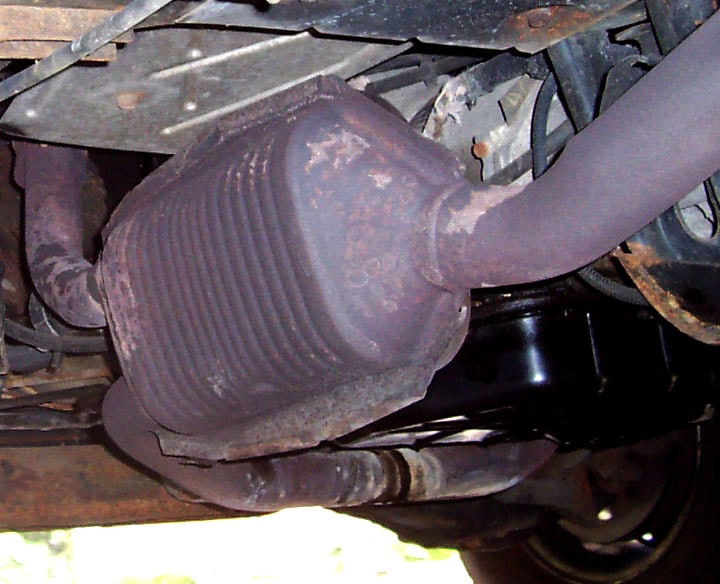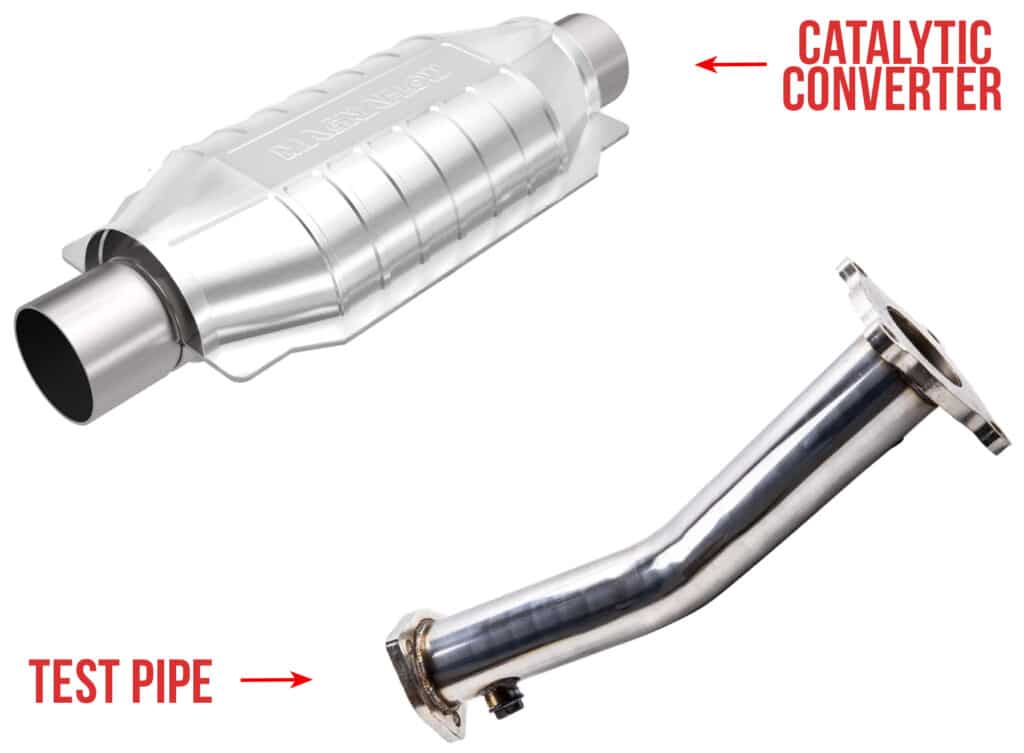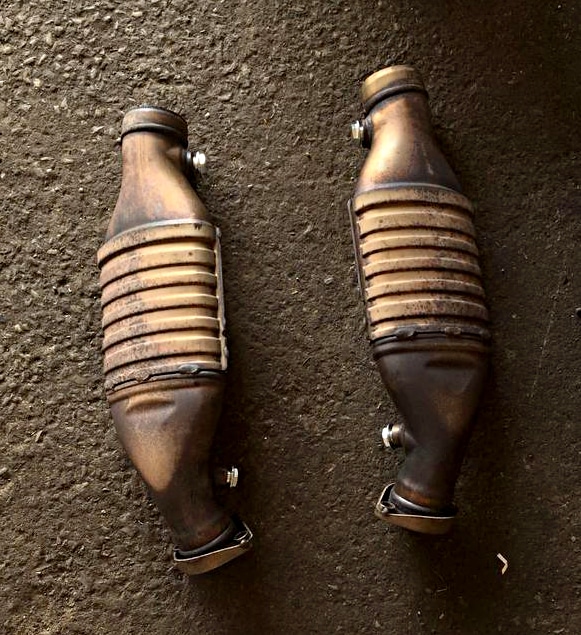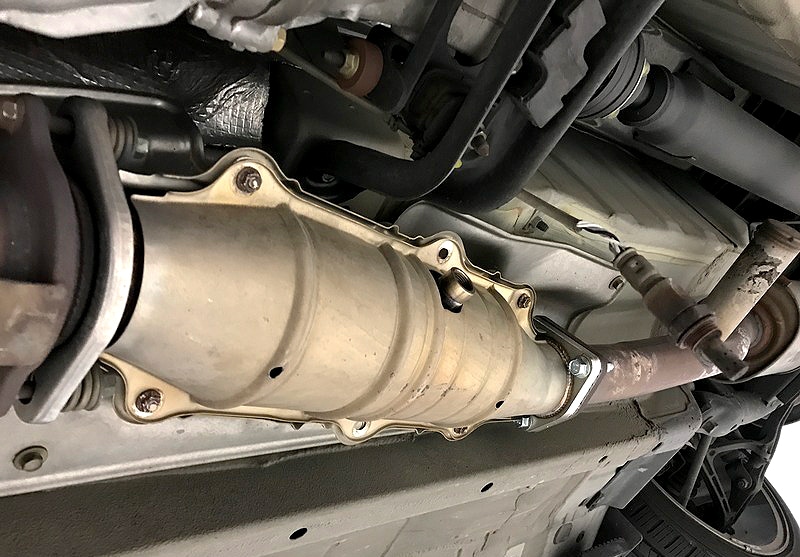Catalytic converters are either the most important or the least important component of your exhaust system depending on what you prioritize more — extra horsepower or ecological sustainability.
Also known as “cat” or “cat-con” for short, the main purpose of a catalytic converter is to convert toxic exhaust pollutants into less-toxic fumes before they get expelled into the atmosphere.
It is mandated by the law for all cars to have a catalytic converter installed from the factory, and it can be highly illegal to remove this component from your exhaust system depending on where you live.
The need for pollution control devices like these arises because internal combustion engines are stupidly inefficient. In an ideal, 100% frictionless engine, all of the hydrogen and carbon present in gasoline would burn completely and convert into carbon dioxide and water.
But technology just isn’t there yet; at least not in a way that’s financially and infrastructurally viable enough to disrupt private transportation.
As it currently stands, of every gallon of gasoline burned by an engine, only 50% of the thermal energy is converted into actual mechanical force.
If 50% sounds bad, know that most cars out on the street, especially if they’re old, blow over 80% of the thermal energy right out through the tailpipe.
This means imperfect combustion, a lot of unburnt fuel, and a lot of heat. The combination of these three characteristics is what produces toxic pollutants.
Here’s where catalytic converters help. But there’s a payoff — while they help to clean up the toxic chemical compounds and give us cleaner air, they also create a restriction in the exhaust system resulting in backpressure and loss of power.
In this article, you’ll get to learn more about what a catalytic converter is, what it does, and why some car enthusiasts like to get rid of it. We’ll also discuss the moral confusion around this subject.
What Does a Catalytic Converter Do?

The catalytic converter is a small metal enclosure that sits in the first half of the exhaust system, sandwiched between two O2 sensors, relatively close to the exhaust manifold.
Before we get into the inner workings of the cat-con, here’s a quick analysis of why it’s called what it’s called.
Catalytic: Implies the use of catalysts (substances that help a reaction take place). Inside the cat-con is a ceramic chamber that’s coated with catalysts.
Converter: The catalysts present in this device help to convert toxic fumes into less toxic fumes.
Let’s dive into a little more detail.
What’s Inside a Catalytic Converter?

The catalytic converter houses a ceramic honeycomb structure that contains thousands of micro-ducts for the exhaust gases to pass through.
These ducts are coated with microscopic particles of three main catalysts — Platinum (Pt), Palladium (Pd), and Rhodium (Rh). Yes, they contain precious metals!
When exhaust gases flow through and come in contact with these catalysts, they get converted into less toxic fumes.

How It Works
The naturally inefficient combustion process of the IC engine creates three notorious pollutants:
- Carbon monoxide: Poisonous to breathe for humans and animals.
- Nitrogen oxide: Leads to smog and acid rain.
- Hydrocarbons: Produce smog.
When exhaust gas passes through the heated ceramic honeycomb (at 426°C / 798.8°F to be exact), two catalytic events occur:
- Reduction Catalyst: Platinum (Pt) and Rhodium (Rh) convert nitrogen oxide to its original state of nitrogen and oxygen.
- Oxidation Catalyst: Platinum (Pt) and Palladium (Pd) oxidize carbon monoxide and unburned hydrocarbons to reduce them into carbon dioxide and water.
Under ideal circumstances, the catalysts remove almost all the toxic gases and less than 1% remains. Most cat-cons have a capacity of one to two liters.
The cat is assisted by two oxygen sensors, one bolted on before and one after. The pre-cat O2 sensor lets your ECU know if there’s enough oxygen burning the fuel in the engine.

And the main O2 sensor tells the ECU if too many hydrocarbons are going through. Based on the data received, the ECU will adjust the fuel-air mixture to bring it as close to the Stoichiometric point as possible.
The Stoichiometric point refers to the imaginary point where all of the fuel entering the engine cylinder will use up all of the oxygen that’s present in the air intake charge. This results in a clean burn with zero wastage and minimal emissions.
What Is a Cat Delete?

Removing the catalytic converter and installing a test pipe in its place is colloquially referred to as a “cat delete”.
Driving your car with no catalytic converter unlocks the true potential of your exhaust system by allowing it to do what it’s supposed to do — scavenging the exhaust gases out of the engine cylinders as quickly and efficiently as possible.

This is one of the cheapest ways to increase horsepower, and an arguably necessary step if you’re building a proper race machine.
Do I Need a Catalytic Converter?
From an engineering and efficiency perspective, it makes perfect sense to not want a catalytic converter. It restricts airflow, creates backpressure, and over-complicates something simple for reasons that don’t favor performance.
But considering private transportation is one of the leading causes of climate change, we had to rethink this stuff. If pollution wasn’t a major problem, we wouldn’t bat an eye at the thought of driving cars without cat-cons.
As tempting as it is to install a free-flowing, screaming exhaust that you know is going to significantly improve the volumetric efficiency of your engine, it’s just not sustainable.
Like many good things that give you momentary pleasure but create problems in the long run — deleting your cat comes with a fair share of consequences.
While the pollution problem won’t necessarily impact you directly (not yet), being confronted by a keen police officer who knows their shit will probably land you in trouble and cost you real money. There’s a reason why there are laws around this.

The ethical question of catalytic converter removal always divides the car community into two distinct groups:
- Those that genuinely care about the environment, and
- Those who haven’t thought about the subject critically enough, and believe that having few straight piped cars on the street isn’t really going to do any damage.
If you belong in the second category, you probably have questions such as:
- What about all the races that I can’t control? Race cars don’t run cats, right?
- Is my keeping the cat-con going to put a dent in this massive problem?
Whether you decide to keep the cat con because you care for the environment or because you want to avoid the hassle of failing emissions tests is up to you. So long as you keep it on, you’ll be doing the planet a favor.
If you absolutely must remove your catalytic converter, ask yourself these questions before going all out:
- Are the emissions laws in my city strict or relaxed?
- Do I have a dedicated track car?
- How often do I hit the track?
- How do I feel about obnoxiously loud exhausts?
Answering these questions for yourself will give you some clarity on whether you should keep it or not. Our bottom line — if you can avoid the cat delete, don’t do it.
High-Flow Cats — A Viable Option

For petrolheads who are keen on maximizing the efficiency of their exhaust systems without having to rip out their catalytic converter, the best option is to install a high-flow catalytic converter.
These are essentially the same as regular cat-cons but they’re designed to preserve horsepower and still provide clean emissions.
High-flow cats contain larger cross-sections within the ceramic honeycomb which does two things:
- Allows the cat to contain more catalysts.
- Maximizes the surface area within the ceramic chamber so that more contact can take place between toxic fumes and the catalysts.
This results in faster, more efficient purification of toxic fumes.
While there’s nothing wrong with leaving your cat-con untouched, we believe that high-flow cats are the perfect exhaust mod for a daily driver. Test pipes can be justified only for competitive use.
Closing Thoughts

Ever since catalytic converters were mandated, toxic exhaust emissions in the USA alone dropped by over 70%. There’s no denying that they help to reduce the environmental impact of private transportation.
And besides, gasoline engines are on their way out. Deleting your catalytic converter and turning your car into a respiratory hazard on wheels is only going to catalyze the problem. Pun intended.
We’d love to know your thoughts on this subject. Do you think it has a positive impact if just one person decides to keep their catalytic converter? Let us know in the comments below!

